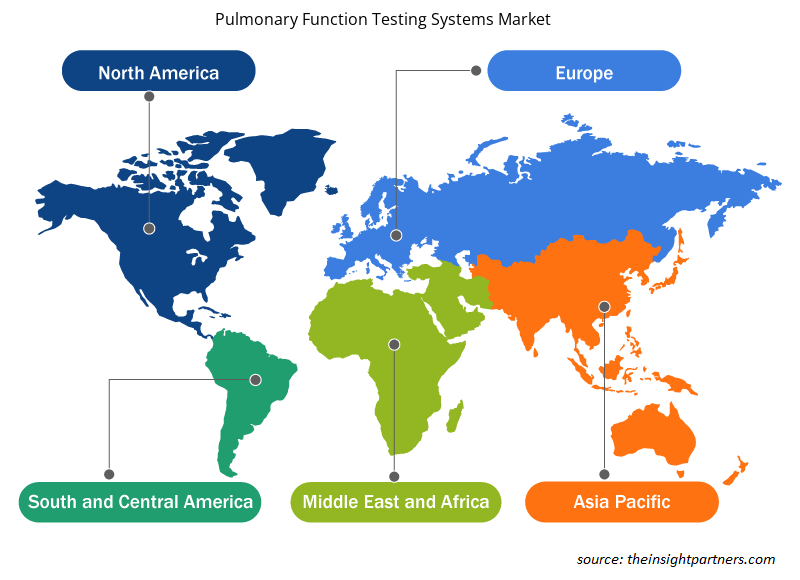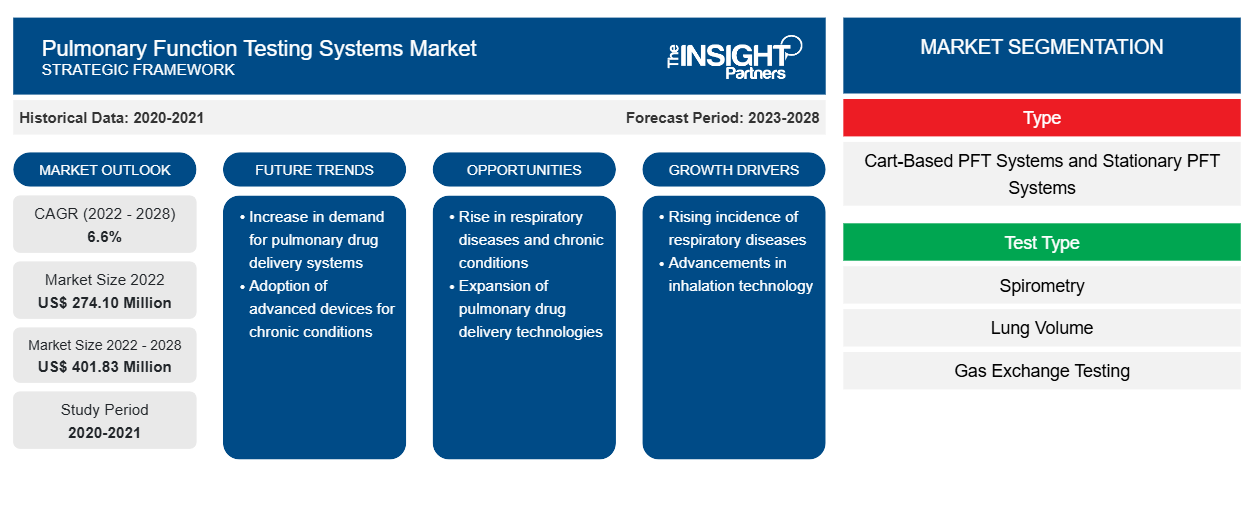肺功能测试系统市场规模预计将从 2022 年的 2.741 亿美元增至 2028 年的 4.0183 亿美元。预计肺功能测试系统市场在 2022 年至 2028 年期间的复合年增长率为 6.6%。
肺功能测试 (PFT) 是一组非侵入性测试,用于测量患者肺部的工作情况。这些测试对于诊断和治疗呼吸系统疾病非常重要。为了进行测试并获得准确的结果,使用正确类型的 PFT 设备和机器非常重要。肺功能测试系统由几种设备组成,用于测量肺功能的不同方面。这可以包括肺部吸入和排出空气的能力、它们将氧气输送到血液的效率以及它们可以容纳多少空气。PFT 测量肺容量、容量和气体交换量。肺部相关疾病和职业性肺部疾病发病率的上升正在推动肺功能测试系统市场规模的扩大。然而,交叉污染的风险和缺乏熟练的专业人员正在阻碍市场的增长。
肺功能测试系统市场根据类型、测试类型、组件、应用、最终用户和地理位置进行细分。就地理位置而言,市场主要分为北美、欧洲、亚太地区、中东和非洲以及南美和中美洲。该报告提供了对市场的见解和深入分析,强调了肺功能测试系统市场趋势、技术进步、市场动态和主要市场参与者的竞争格局分析等参数。
定制此报告以满足您的需求
您可以免费定制任何报告,包括本报告的部分内容、国家级分析、Excel 数据包,以及为初创企业和大学提供优惠和折扣
- 获取此报告的关键市场趋势。这个免费样品将包括数据分析,从市场趋势到估计和预测。
市场洞察
肺部相关疾病发病率上升
根据英国肺脏基金会 2023 年的报告,英国每周约有 10,000 人被新诊断出患有肺病。此外,肺病导致超过 70,00,000 人住院,英国每年有 600 万住院日。因此,肺功能测试 (PFT) 系统在诊断和监测方面非常有用。PFT 系统提供准确的结果,特别是肺容量、容量、流速和气体交换。此外,PFT 系统的使用有助于评估哮喘、肺气肿和其他慢性肺部疾病的治疗。通过评估肺容量、容量、流速和气体交换,PFT 可以提供可供医生评估的信息,以帮助有效诊断某些肺部疾病并为患者决定正确的治疗方法。此外,PFT 是非侵入性程序,通常由医生推荐给无需住院的患者。市场上可用的商业肺功能测试系统包括肺量计。肺量计测试有助于确定患者是否患有肺病、肺病类型、肺病进展和肺病损伤。肺量计测量气流,可以评估患者的多种肺病。因此,肺相关疾病发病率的上升推动了肺功能测试系统的使用。
基于类型的洞察
根据类型,肺功能测试系统市场分为推车式 PFT 系统和固定式 PFT 系统。推车式系统在 2022 年占据了更大的市场份额。此外,预计在预测期内,推车式系统将在市场上实现更高的复合年增长率。
基于测试类型的见解
就测试类型而言,肺功能测试系统市场已细分为肺量测定、肺容量、气体交换测试、最大自主通气量、氧滴定测试等。肺量测定部分在 2022 年占据了最大的市场份额。此外,预计肺容量部分在预测期内将在市场上实现最高的复合年增长率。
基于组件的洞察
根据组件,肺功能测试系统市场细分为硬件、软件和服务。硬件部分在 2022 年占据了最大的市场份额。预计软件部分将在预测期内实现最高的复合年增长率。
基于应用的洞察
根据应用,肺功能测试系统市场细分为慢性阻塞性肺病 (COPD)、哮喘、慢性呼吸短促、限制性肺病等。慢性阻塞性肺病 (COPD) 细分市场在 2022 年占据了最大的市场份额。此外,预计同一细分市场在预测期内将实现最高的复合年增长率。
基于最终用户的洞察
根据最终用户,肺功能测试系统市场已细分为医院、专科诊所和诊断中心。医院部门在 2022 年占据了最大的市场份额。预计专科诊所部门将在预测期内实现最高的复合年增长率。
COVID-19 是一种呼吸系统感染,可能迅速引起类似肺炎的症状和胸部感染。这可能会导致患者的健康状况下降。呼吸机有助于管理患者的气体交换。由于 COVID-19 疫情,对肺功能测试系统的需求非常高。美国肺脏协会和疾病控制与预防中心建议 COVID-19 症状轻微的患者进行肺功能测试以检查患者的肺活量。肺功能测试是评估主要攻击心肺系统的病毒的生理影响的理想工具。测量气流、肺容量以及氧气和二氧化碳在肺泡和血液之间转移的能力的技术已经很成熟,并且在美国各地都有进行这些测试的设施。
肺功能测试系统市场中的公司通常采用产品发布和扩张策略来扩大其全球业务范围并满足不断增长的需求。他们对产品创新的关注使他们能够满足不断变化的客户需求并在全球范围内保持其品牌知名度。
- 2022 年 6 月,ndd Medical Technologies (ndd) 更新了整个 EasyOne 产品系列,包括 EasyOne Air、Easy on-PC、EasyOne Pro 和 EasyOne Pro LAB,以符合 ATS/ERS 肺量测定 2019 标准化。
- 2021 年 4 月,Vyaire Medical 宣布在欧洲推出 ArtiQ.PFT,这是一款由人工智能驱动的自动化工具,可即时解释肺功能测试 (PFT)。ArtiQ.PFT 是第一个利用人工智能的基于云的 PFT 解决方案。
就地理分布而言,全球肺功能测试系统市场分为北美(美国、加拿大和墨西哥)、欧洲(法国、德国、英国、西班牙、意大利和欧洲其他地区)、亚太地区(中国、印度、日本、澳大利亚、韩国和亚太地区其他地区)、中东和非洲(沙特阿拉伯、阿联酋、南非和中东和非洲其他地区)以及南美洲和中美洲(巴西、阿根廷和南美洲和中美洲其他地区)。
肺功能测试系统市场区域洞察
Insight Partners 的分析师已详尽解释了预测期内影响肺功能测试系统市场的区域趋势和因素。本节还讨论了北美、欧洲、亚太地区、中东和非洲以及南美和中美洲的肺功能测试系统市场细分和地理位置。

- 获取肺功能测试系统市场的区域特定数据
肺功能测试系统市场报告范围
| 报告属性 | 细节 |
|---|---|
| 2022 年市场规模 | 2.741亿美元 |
| 2028 年市场规模 | 4.0183亿美元 |
| 全球复合年增长率(2022 - 2028) | 6.6% |
| 史料 | 2020-2021 |
| 预测期 | 2023-2028 |
| 涵盖的领域 | 按类型
|
| 覆盖地区和国家 | 北美
|
| 市场领导者和主要公司简介 |
|
肺功能测试系统市场参与者密度:了解其对业务动态的影响
肺功能测试系统市场正在快速增长,这得益于终端用户需求的不断增长,而这些需求又源于消费者偏好的不断变化、技术进步以及对产品优势的认识不断提高等因素。随着需求的增加,企业正在扩大其产品范围,进行创新以满足消费者的需求,并利用新兴趋势,从而进一步推动市场增长。
市场参与者密度是指在特定市场或行业内运营的企业或公司的分布情况。它表明在给定市场空间中,相对于其规模或总市场价值,有多少竞争对手(市场参与者)存在。
在肺功能测试系统市场运营的主要公司有:
- 席勒
- 康美德公司
- MGC 诊断公司
- 甘绍兰电子医疗
- ndd 医疗技术公司
免责声明:上面列出的公司没有按照任何特定顺序排列。

- 了解肺功能测试系统市场主要参与者概况
公司简介
- 康美德有限公司
- MGC 诊断公司
- 摩根科学公司
- 港医疗科学株式会社
- 席勒股份公司
- Chest MI 公司
- Vyaire 医疗公司
- ndd 医疗技术公司
- PulmOne 先进医疗器械有限公司
- KoKo PFT 有限公司
- 历史分析(2 年)、基准年、预测(7 年)及复合年增长率
- PEST 和 SWOT 分析
- 市场规模价值/数量 - 全球、区域、国家
- 行业和竞争格局
- Excel 数据集



Report Coverage
Revenue forecast, Company Analysis, Industry landscape, Growth factors, and Trends

Segment Covered
This text is related
to segments covered.

Regional Scope
North America, Europe, Asia Pacific, Middle East & Africa, South & Central America

Country Scope
This text is related
to country scope.
常见问题
COSMED Srl, MGC Diagnostics Corp, Morgan Scientific Inc, Minato Medical Science Co Ltd, Schiller AG, Chest MI Inc, Vyaire Medical Inc, ndd Medical Technologies Inc, PulmOne Advanced Medical Devices Ltd, KoKo PFT Ltd, and among others are among the leading companies operating in the pulmonary function testing systems market.
Global pulmonary function testing systems market is segmented by region into North America, Europe, Asia Pacific, Middle East & Africa, and South & Central America.
Hospitals segment dominated the global pulmonary function testing systems market and accounted for the largest market share during the forecast period of 2022-2028.
Based on the application, chronic obstructive pulmonary disorder segment took the forefront leaders in the worldwide market by accounting largest share in 2021.
Based on type segment, the cart-based PFT systems segment took the forefront leaders in the worldwide market by accounting largest share in 2021 and is expected to continue to do so till the forecast period.
Rising incidence of lung-related disorders and occupational lung diseases are the most significant factors responsible for the overall market growth.
Pulmonary functioning testing (PFT) is a set of noninvasive tests that are used to measure how well a patient’s lungs are working. This is important in the diagnosis and treatment of those with respiratory diseases. In order to perform the tests and obtain accurate results, it is important to use the right types of PFT equipment and machines. There are several different devices in system. Pulmonary functioning testing system is made up of several devices that are used to measure different aspects of lung function. This can include how well the lungs take in and expel air, how efficiently they transfer oxygen to the blood, and how much air the lungs can hold. PFT’s measure lung volumes, capacities, and the amount of gas exchange.
Trends and growth analysis reports related to Life Sciences : READ MORE..
The List of Companies - Pulmonary Function Testing Systems Market
- SCHILLER
- COSMED srl
- MGC Diagnostics Corporation
- Ganshoran Medizin Electronic
- ndd Medical Technologies
- Morgan Scientific Inc.
- Pulm One Advanced Medical Devices Ltd
- CHEST M.I., Inc
- Vyaire Medical, Inc.
- Koko LLC
The Insight Partners performs research in 4 major stages: Data Collection & Secondary Research, Primary Research, Data Analysis and Data Triangulation & Final Review.
- Data Collection and Secondary Research:
As a market research and consulting firm operating from a decade, we have published and advised several client across the globe. First step for any study will start with an assessment of currently available data and insights from existing reports. Further, historical and current market information is collected from Investor Presentations, Annual Reports, SEC Filings, etc., and other information related to company’s performance and market positioning are gathered from Paid Databases (Factiva, Hoovers, and Reuters) and various other publications available in public domain.
Several associations trade associates, technical forums, institutes, societies and organization are accessed to gain technical as well as market related insights through their publications such as research papers, blogs and press releases related to the studies are referred to get cues about the market. Further, white papers, journals, magazines, and other news articles published in last 3 years are scrutinized and analyzed to understand the current market trends.
- Primary Research:
The primarily interview analysis comprise of data obtained from industry participants interview and answers to survey questions gathered by in-house primary team.
For primary research, interviews are conducted with industry experts/CEOs/Marketing Managers/VPs/Subject Matter Experts from both demand and supply side to get a 360-degree view of the market. The primary team conducts several interviews based on the complexity of the markets to understand the various market trends and dynamics which makes research more credible and precise.
A typical research interview fulfils the following functions:
- Provides first-hand information on the market size, market trends, growth trends, competitive landscape, and outlook
- Validates and strengthens in-house secondary research findings
- Develops the analysis team’s expertise and market understanding
Primary research involves email interactions and telephone interviews for each market, category, segment, and sub-segment across geographies. The participants who typically take part in such a process include, but are not limited to:
- Industry participants: VPs, business development managers, market intelligence managers and national sales managers
- Outside experts: Valuation experts, research analysts and key opinion leaders specializing in the electronics and semiconductor industry.
Below is the breakup of our primary respondents by company, designation, and region:

Once we receive the confirmation from primary research sources or primary respondents, we finalize the base year market estimation and forecast the data as per the macroeconomic and microeconomic factors assessed during data collection.
- Data Analysis:
Once data is validated through both secondary as well as primary respondents, we finalize the market estimations by hypothesis formulation and factor analysis at regional and country level.
- Macro-Economic Factor Analysis:
We analyse macroeconomic indicators such the gross domestic product (GDP), increase in the demand for goods and services across industries, technological advancement, regional economic growth, governmental policies, the influence of COVID-19, PEST analysis, and other aspects. This analysis aids in setting benchmarks for various nations/regions and approximating market splits. Additionally, the general trend of the aforementioned components aid in determining the market's development possibilities.
- Country Level Data:
Various factors that are especially aligned to the country are taken into account to determine the market size for a certain area and country, including the presence of vendors, such as headquarters and offices, the country's GDP, demand patterns, and industry growth. To comprehend the market dynamics for the nation, a number of growth variables, inhibitors, application areas, and current market trends are researched. The aforementioned elements aid in determining the country's overall market's growth potential.
- Company Profile:
The “Table of Contents” is formulated by listing and analyzing more than 25 - 30 companies operating in the market ecosystem across geographies. However, we profile only 10 companies as a standard practice in our syndicate reports. These 10 companies comprise leading, emerging, and regional players. Nonetheless, our analysis is not restricted to the 10 listed companies, we also analyze other companies present in the market to develop a holistic view and understand the prevailing trends. The “Company Profiles” section in the report covers key facts, business description, products & services, financial information, SWOT analysis, and key developments. The financial information presented is extracted from the annual reports and official documents of the publicly listed companies. Upon collecting the information for the sections of respective companies, we verify them via various primary sources and then compile the data in respective company profiles. The company level information helps us in deriving the base number as well as in forecasting the market size.
- Developing Base Number:
Aggregation of sales statistics (2020-2022) and macro-economic factor, and other secondary and primary research insights are utilized to arrive at base number and related market shares for 2022. The data gaps are identified in this step and relevant market data is analyzed, collected from paid primary interviews or databases. On finalizing the base year market size, forecasts are developed on the basis of macro-economic, industry and market growth factors and company level analysis.
- Data Triangulation and Final Review:
The market findings and base year market size calculations are validated from supply as well as demand side. Demand side validations are based on macro-economic factor analysis and benchmarks for respective regions and countries. In case of supply side validations, revenues of major companies are estimated (in case not available) based on industry benchmark, approximate number of employees, product portfolio, and primary interviews revenues are gathered. Further revenue from target product/service segment is assessed to avoid overshooting of market statistics. In case of heavy deviations between supply and demand side values, all thes steps are repeated to achieve synchronization.
We follow an iterative model, wherein we share our research findings with Subject Matter Experts (SME’s) and Key Opinion Leaders (KOLs) until consensus view of the market is not formulated – this model negates any drastic deviation in the opinions of experts. Only validated and universally acceptable research findings are quoted in our reports.
We have important check points that we use to validate our research findings – which we call – data triangulation, where we validate the information, we generate from secondary sources with primary interviews and then we re-validate with our internal data bases and Subject matter experts. This comprehensive model enables us to deliver high quality, reliable data in shortest possible time.


 获取此报告的免费样本
获取此报告的免费样本